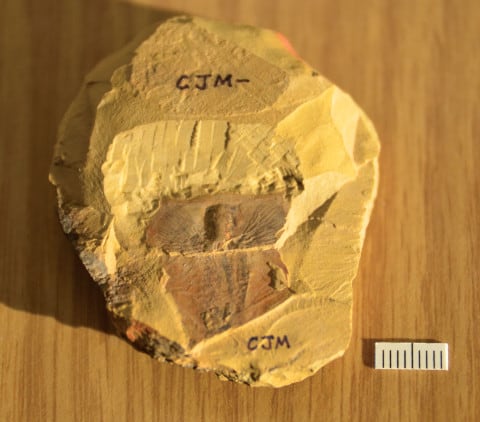TAYLOR BOROWETZ

Brian Pratt and his team used synchotrons at the U of S and Stanford University to study samples such as this one.
University of Saskatchewan researchers hypothesize the blood of some early invertebrates could have actually been a brilliant blue from the copper contained in the blood instead of iron.
Brian Pratt, a palaeontologist and sedimentologist, lead the team and is primarily interested in sedimentary rocks from the Cambrian age — about half a billion years old. These rocks hold important clues from the beginning of animal evolution.
Fossilization occurs in sedimentary rock and normally only preserves the parts of the organism that were composed of minerals while alive, such as hard shells or skeletons.
Located in the Canadian Rockies, the Burgess Shale Formation is a unique exception. American palaeontologist Charles Walcott found the Burgess Shale in 1922 by accident while searching for fossilized trilobites, an extinct group of marine arthropods.
The shale itself looks like a dark mix of greenish, gray and black rock. It is almost totally unique because the decay of carcasses in the shale stopped prematurely. Rather than leaving no trace, as would usually be expected, soft-bodied organisms and non-mineralized tissues were preserved.
Pratt convinced some of his colleagues who work at the Canadian Light Source to test the composition of some of these unusual fossils, including samples from the Burgess Shale. The samples were imaged using the synchrotrons at the U of S and Stanford University. No other tools could have detected the composition of the fossils on the same level of resolution as a synchrotron because of the size of the samples.
The team chose to focus specifically on Marrella splendens; a tiny, feathery, bug-like arthropod. An arthropod is an invertebrate with an exoskeleton, segmented body and jointed appendages.
Marrella splendens is a small organism, less than two centimeters in length, but their scientific appeal does not lie in their size. Pratt said half of the Marrella fossils in the Burgess Shale have a dark stain around the edges, head, or thorax and his team has argued that this stain is the remains of the organism’s blood. Pratt’s team hypothesizes that after the organism had died, blood continued to pump out and spill into the surrounding sediment, causing the stain.
The scans showed that there were elevated concentrations of copper in the darkened blood stains. Pratt explains, though there are trace amounts of copper in seawater, along with zinc, iron and other elements, it would have likely been disseminated in the shale as opposed to its concentration in the stain area.
“We think that it is the remnants of hemocyanin,” Pratt said.
Hemocyanin is a protein in blood that uses copper to transport oxygen, as opposed to iron hemoglobin used in our blood. Both function similarly by binding oxygen to the central atom or the iron or copper. Because of the copper, hemocyanin is a brilliant blue similar to copper sulfate.
Pratt said finding these organisms used hemocyanin would not be surprising, as marine crustaceans and arthropods use it today. For example, hemocyanin is extracted from horseshoe crabs in Chesapeake Bay, Mass. and used to treat bladder tumors.
The novelty of their work lies in the fact that this is the first evidence for invertebrate blood composition to be found in fossil.
Their article, “Evidence for biogenic copper (hemocyanin) in the middle Cambrian arthropod Marrella from the Burgess Shale” is published in PALAIOS and can be accessed through other online journals through the university library website.
—
Photos: Katherine Fedoroff/Photo Editor